ATI Radeon HD 5450: Eyefinity And HTPCs For Everyone?
Budget Eyefinity
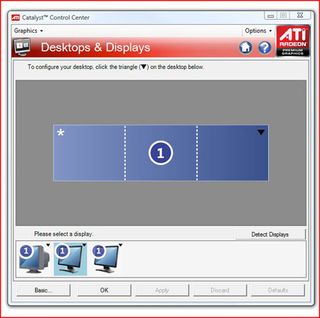
Eyefinity is the marking name for a feature that will definitely appeal to many potential buyers, and the Radeon HD 5450 is perhaps most attractive to non-gamers with a practical need for a triple-monitor setup (artists, day traders, multi-tasking technology writers, anyone?). With an abundance of older 17" LCD monitors--perhaps around as spares or up for grabs on the used market--the appeal of an inexpensive triple-display configuration undeniable. A 17" monitor with a 4:3 aspect ratio (that's the standard 1280x1024 size) is almost the exact same height as a 19" or 20" widescreen LCD. Therefore, two 17-inch monitors would complement that 20" nicely, don't you think? This author has an old spare 17" LCD on a secondary system, and I found a used 17" on Kijiji for $50. If I put these beside my 20" widescreen monitor, I'm good to go for Eyefinity, right?
Not so fast. While Eyefinity is a fantastic tool, and we're glad to see it up and down ATI's Radeon HD 5000-series, it does have a couple major drawbacks in a budget-oriented environment. The most significant restriction is mandatory DisplayPort use. In a triple-display setup, at least one monitor must use the card's DisplayPort output. If one of the displays doesn't have a DisplayPort input, the user must purchase an active DisplayPort to HDMI/DVI/VGA converter in order for it to work. The active part is key because it means a low-cost passive converter won't work. Unfortunately, most active DisplayPort-to-HDMI/DVI converters seem to be in the $100 range.
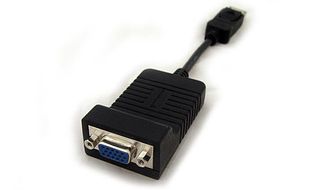
The implication here is that a user needs to invest money into a new DisplayPort monitor, which tend to be rarer and more expensive than non-DisplayPort models, or spend an extra $100 on a DisplayPort converter. Either option is a bit of a killjoy.
There is a way around this limitation however. It turns out that there are a number of low-cost active DisplayPort to VGA dongles out there, and these do the trick. The VGA dongle limits the maximum resolution somewhat, but we were able to set the 20" monitor to its native 1680x1050 resolution without a problem in extended desktop mode. In this case, we used a Startech DisplayPort to VGA adapter (model DP2VGA) that we picked up locally. We have also heard reports that Bytecc's AP-DPVGA also works for this application, and can be found online for under $25.
Indeed, we began our testing with a Radeon HD 5770, the adapter, a 20" widescreen center monitor, and two 17" satellites on the sides. We used the DisplayPort to VGA dongle on the 20" center monitor, because we found the dongle needs to be used on the monitor with the highest resolution in order for it to work. One of the 17" monitors employed a native DVI cable and the other used a DVI-to-VGA converter.
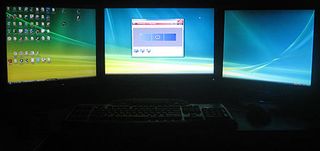
Eyefinity even allowed us to group the monitors into a single desktop, a requirement for gaming use. We were on our way! There are still a number of Eyefinity limitations, however. Group resolution is limited to a multiple for all three displays, so we couldn't set the middle display to 1680x1024 and flanking displays to 1280x1024 for the ideal 4240x1024 group resolution. Instead, Eyefinity limited us to 1280x1024 per monitor, or 3840x1024.
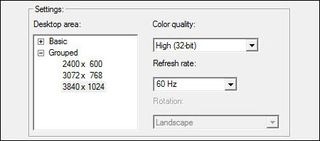
As a result, the center monitor stretched this 4:3 resolution to its 16:10 window, which was not as attractive as we'd hoped. There are some workarounds for games, including ways to alter the player's field of view and aspect ratio (in the CoD: MW2 screenshot below, we've used a freeware utility called Widescreen Fixer). But, for the most part, players who want to duplicate this setup will be stuck with a stretched middle screen that isn't ideal. If you're looking to build a multi-monitor budget gaming machine, you're almost certainly better off buying three identical displays.
Stay on the Cutting Edge
Join the experts who read Tom's Hardware for the inside track on enthusiast PC tech news — and have for over 25 years. We'll send breaking news and in-depth reviews of CPUs, GPUs, AI, maker hardware and more straight to your inbox.
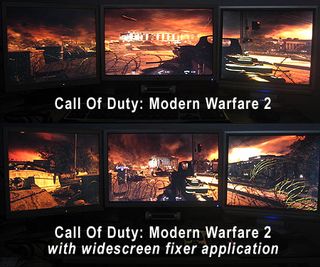
Now for the bad news on our end. Although we were able to get our cost-conscious Eyefinity setup working with the Radeon HD 5770 sample, it wasn't working with the Radeon HD 5450. It seems as though our DisplayPort to VGA dongle takes the blame on this one, as it isn't on AMD's list of Eyefinity-validated dongles. After checking back with AMD, which was able to test the card in its own lab using an Accel B101B-001B DisplayPort to VGA active dongle, the company confirmed Eyefinity was working as expected. The moral of the story: make sure you cross-check the compatibility list before investing in the complementary hardware needed to get Eyefinity going.
Current page: Budget Eyefinity
Prev Page ATI's Radeon HD 5450 Architecture Next Page HTPC And Stream-
popaholic For the all the idiots out there, yes it can run Crysis, slightly.Reply
Whats the point of releasing a new graphics card thats worse than older cards? It runs Dx11 but there's no way it could even run a supported game.
-
The links to the article pages are either missing or directed wrongly. For example, the "Power and Temperature Benchmarks", "Conclusion" pages are missing or directed wrongly.Reply
-
cangelini serokichimThe links to the article pages are either missing or directed wrongly. For example, the "Power and Temperature Benchmarks", "Conclusion" pages are missing or directed wrongly.Reply
Try refreshing the page. Should be working correctly now! -
acasel a crossfire config with this video card + overclock will make this article much better in a gamers point of view...Reply -
cleeve acasela crossfire config with this video card + overclock will make this article much better in a gamers point of view...Reply
Not really, look at the specs. In CrossFire these cards would cost $100 for a total 160 shader cores. They still wouldn't hold a candle to a single $100 5670 when gaming, which has 400 shader cores all by itself.
CrossFiring the 5450 would be a total waste. -
masterjaw Passively-cooled 5450 in crossfire = failReply
How do you expect it to handle the increase in temps? Even if you got some good airflow inside the case, that won't be sufficient. -
skora How selfish you all are thinking THG only does gaming cards!!!! When ATI cuts the hardware (shaders/ROPs) to the bone, its not about gaming. Its for the HTPC and multi-monitor office crowd and thats it. It's a niche card and looks to do that admirably.Reply -
shubham1401 Lol...Reply
They needed a i7 and 1200W PSU to test this card... :)
Useless...Either get a good card or stick with integrated.
Most Popular

